One of the challenges we’ve had on our sake journey is figuring how to pair it with non-Japanese food. We’ve not had much success with spicy South-East Asian dishes, and it’s been hit-and-miss for Chinese cuisine.
We’re still keen to give it a decent try, and when we found out that Xi Yan (囍宴) was hosting a special one-night only junmai daiginjo sake-paired dinner, we quickly gathered reinforcements and made a reservation.
Xi Yan has been on our list of Chinese restaurants to try for the longest time, but we never got round to actually going. So, this would effectively be a one-stone-two-birds dinner.
Their location at Maxwell Chambers is small-ish but warm and cosy. It’s filled with many Chinese modern art pieces, including mini flying pig figurines and a cute (but somewhat violent) painting of a kung fu rickshaw girl which The Wife really liked.
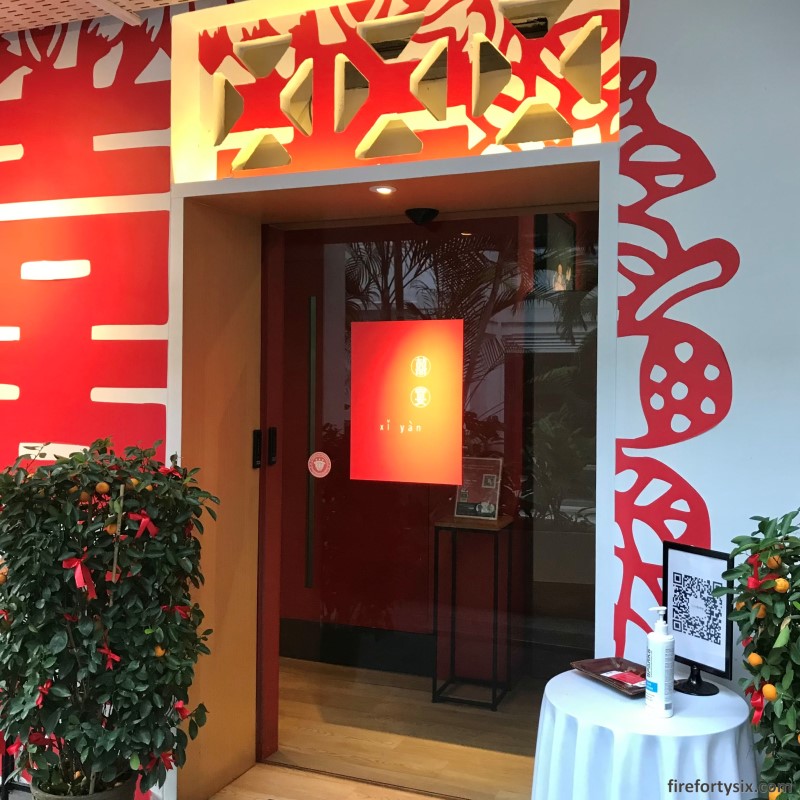
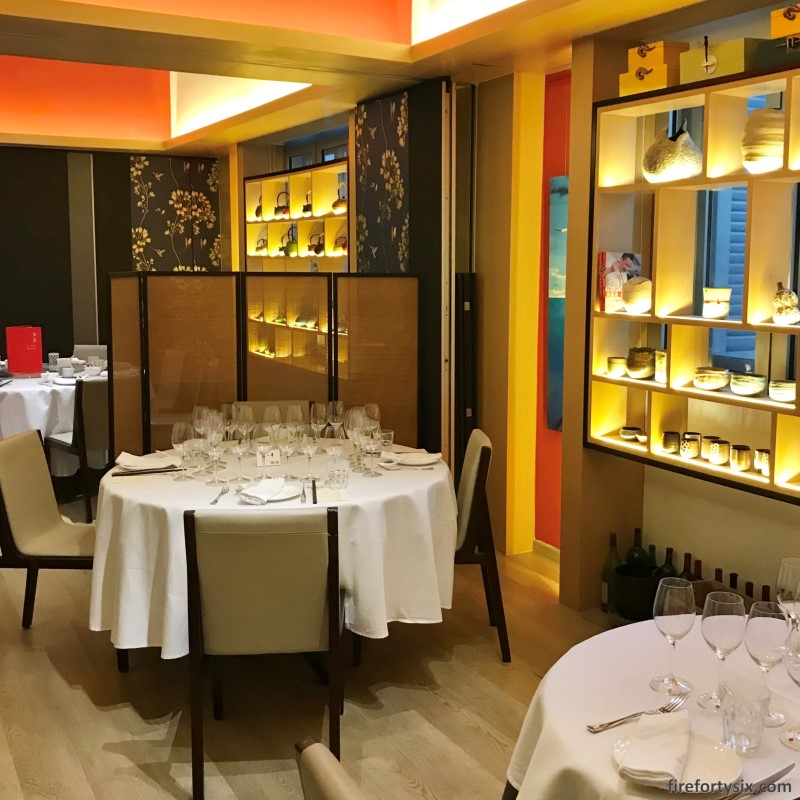

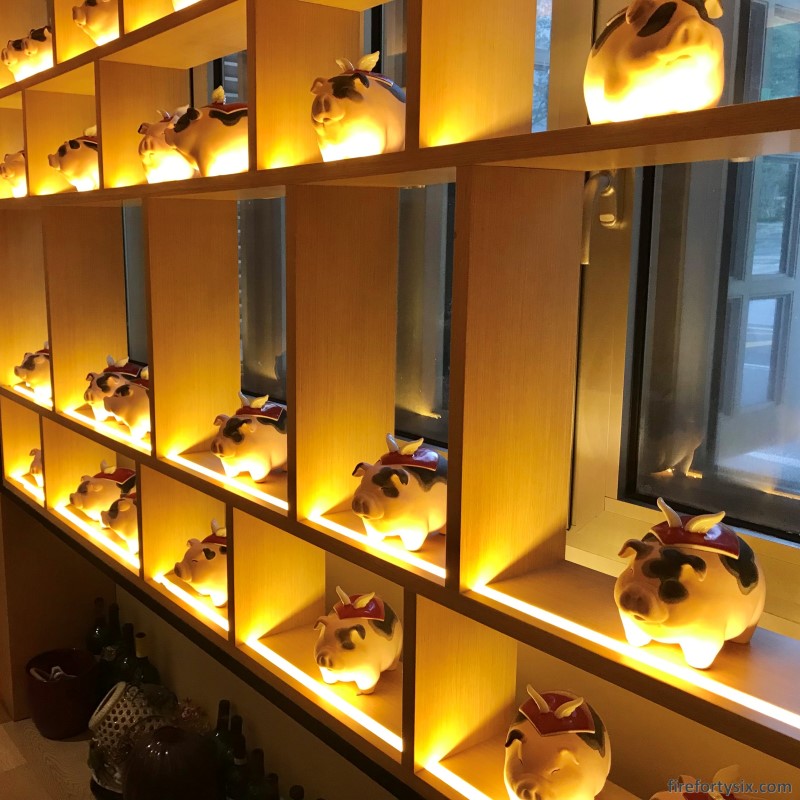
When we were led to our table for the night, we were greeted with an intimidating setup of 24 wine glasses. Each of us would be surrounded by a crescent-shaped glass fortress throughout the night.
Frankly, it was a strange table setting that we’ve never encountered before. But I can understand how it would have made service easier, especially with the acute staff shortage that restaurants are currently facing. Having to pour/serve/collect one glass at a time would probably have stretched already limited resources a bit too far.
Each glass was marked with different-coloured sticker at the base, which corresponded to the specific sake that would be poured. The benefits were two-fold: our servers would know which glass to pour into, and we’d be able to tell what we were actually drinking.
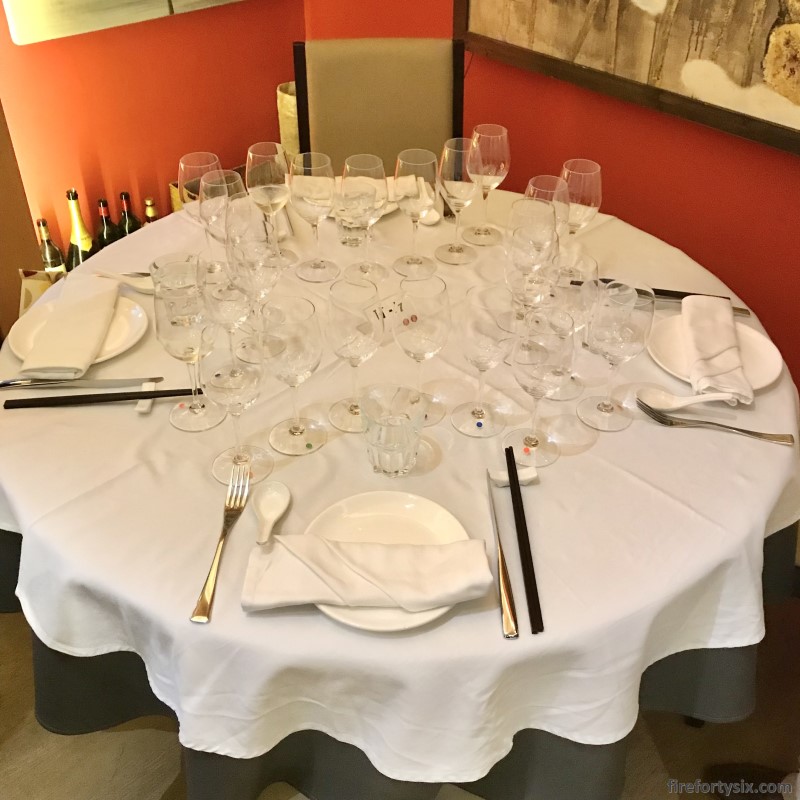
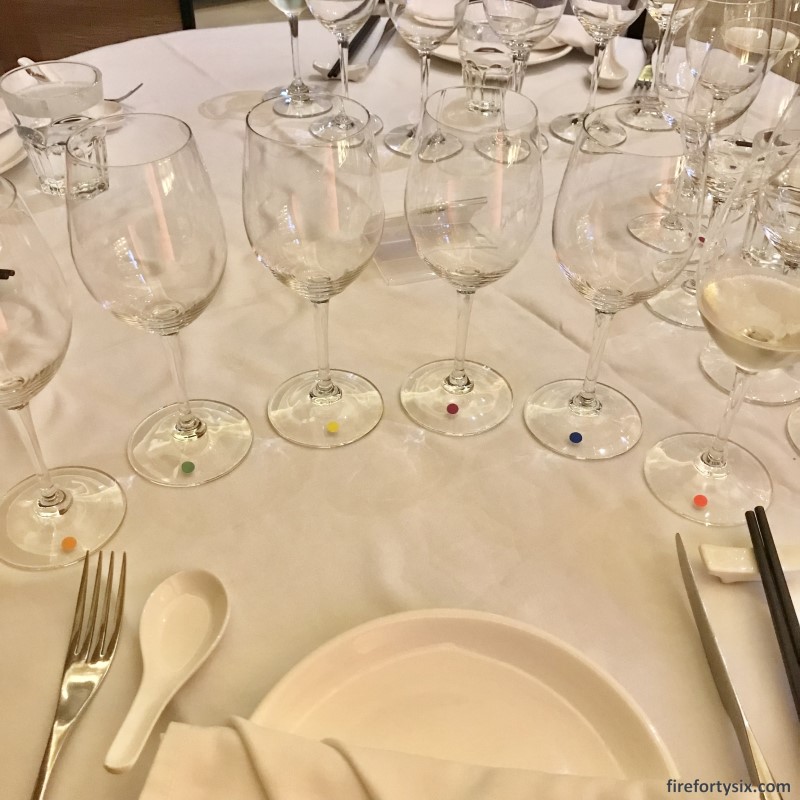
The sake line-up for the night was prominently displayed on a separate table by the window. It comprised of familiar names like Choya, Umenoyado, Hakkaisan, Born and Nanbubijin, plus Ohmine, a brand that was new to me.
I was looking forward to an enjoyable night of good food, nice sake and wonderful company, courtesy of our good friends JM and SL. Unfortunately SL doesn’t drink, but she’s a foodie, and the menu looked interesting enough to keep her sufficiently entertained.
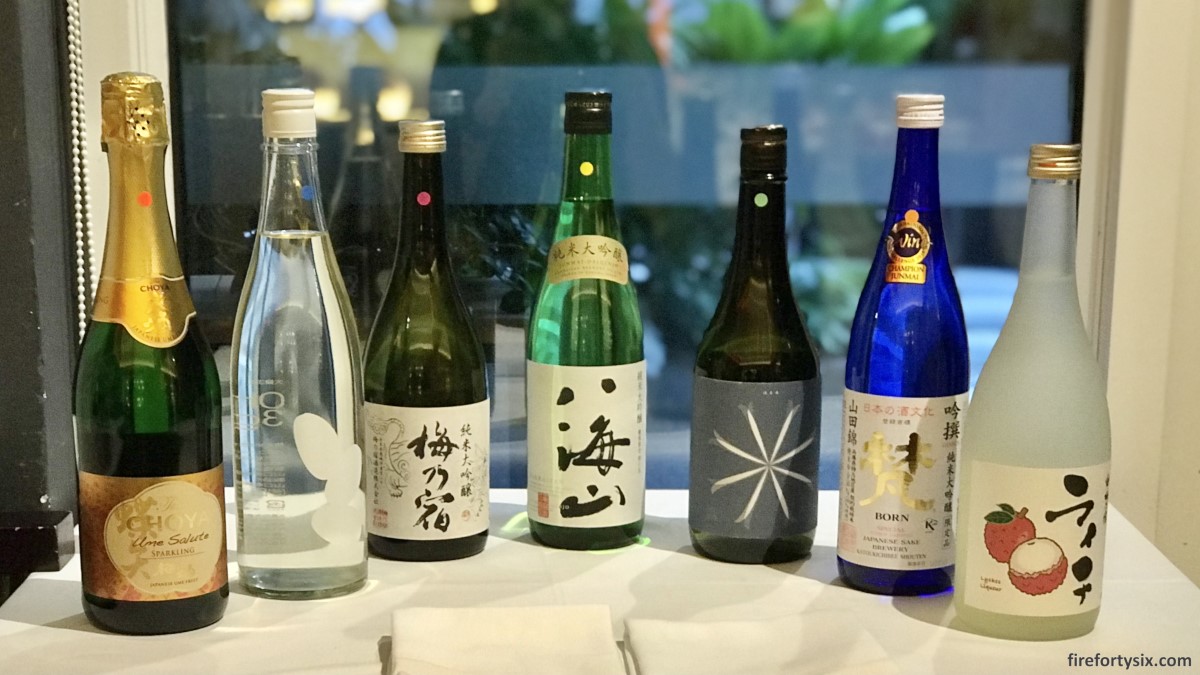
Dinner would be served over eight courses, covering a wide selection of land, sea and air creatures. The dishes included classic Chinese staples like roast chicken and stewed grouper, as well as some interesting fusion interpretations.
The common element across all the dishes was strong and robust flavours, which was a bit concerning to me, given that the sakes would mostly be junmai daiginjos.
In our limited experience, JDGs have generally tasted quite good on their own, but tend to be overwhelmed when paired with heavily-seasoned food. Well, I suppose there’s only one way to find out.
Ikimasho!
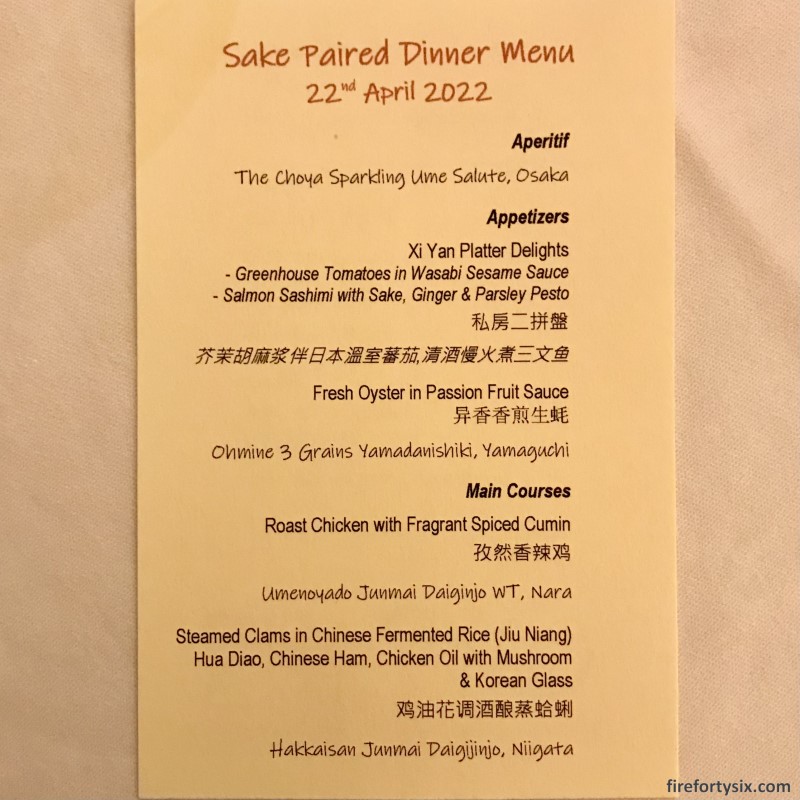
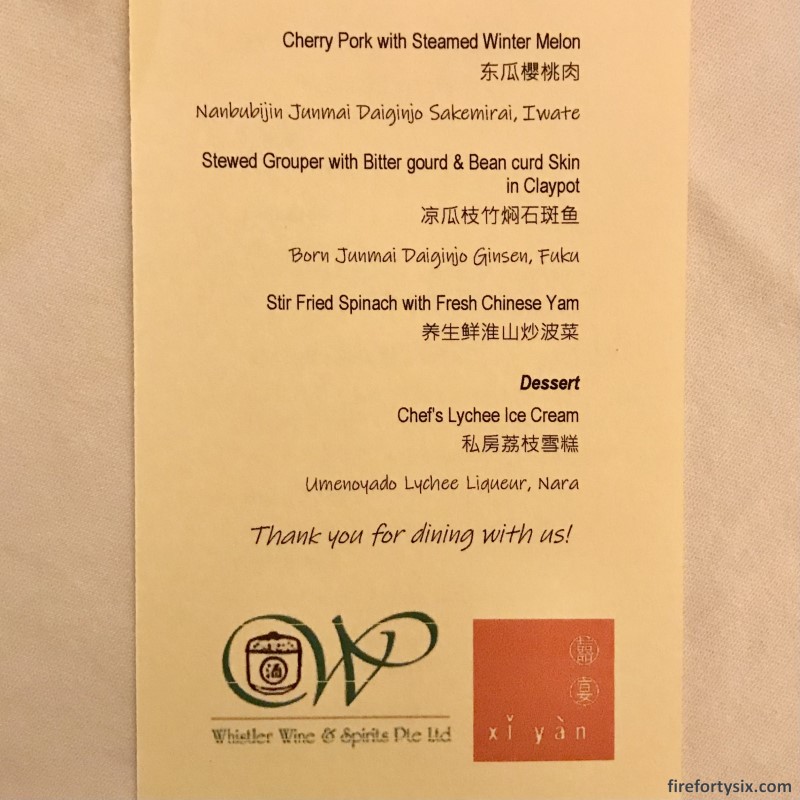
Round One: The Choya Sparkling Ume Salute vs Xi Yan Platter Delights
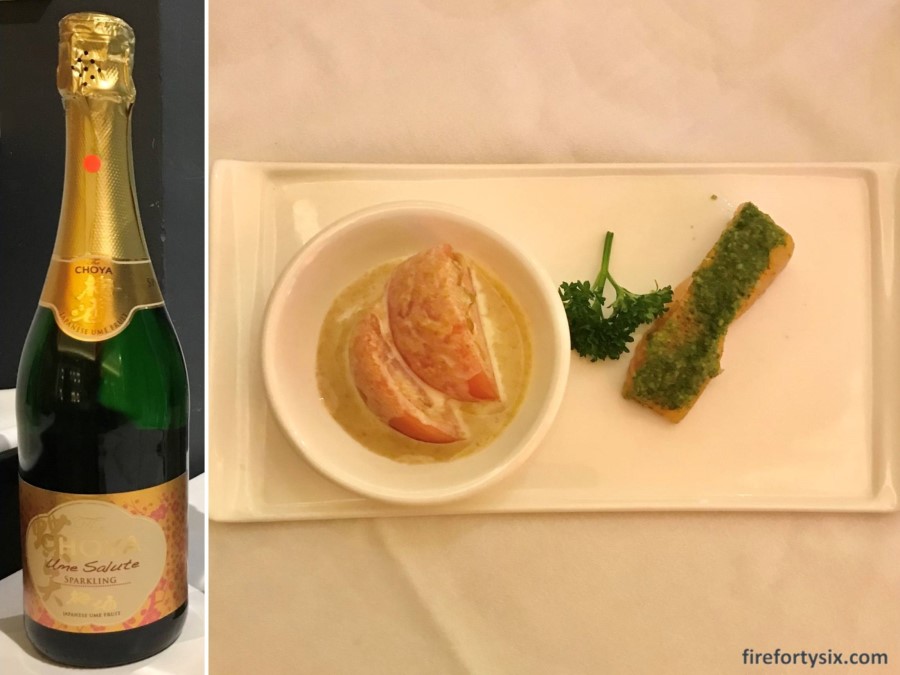
The effervescent Choya was refreshingly sweet, and went well with the two appetisers of greenhouse tomatoes in wasabi sesame sauce and salmon sashimi with sake, ginger and parsley pesto.
The tomatoes were straight-up a Japanese dish, but the salmon was an interesting fusion item, using a topping that’s typically served with poached chicken. Both were delicious and really helped to open up our palates for the following courses.
I thought that they could have gone with a sparkling awa sake to stay on theme, but the sparkling umeshu was nonetheless a decent choice. It went well with the heavy flavours of the wasabi goma sauce and spicy and herby pesto.
Round Two: Ohmine 3 Grains Yamadanishiki vs Fresh Oyster in Passion Fruit Sauce
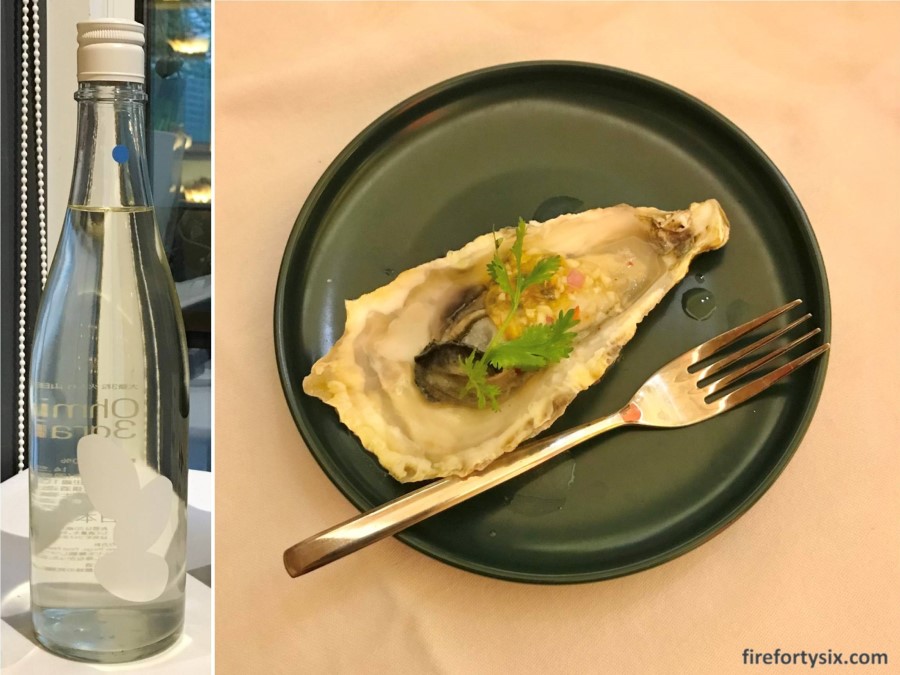
Passion fruit sauce was a unique choice to go with raw oysters, but it had just the right level of sweetness and tartness to make it work. The combination with the plump and juicy oyster made for a delicious morsel.
I was worried that the sourness would completely overwhelm the Ohmine, but the sake held up surprisingly well with its mild umami sweetness. The SMV was undisclosed, but I would guess that it was probably between -1 and +1.
I’ve not come across Ohmine sakes before, but after this glass, I’ll definitely be looking out for it. This particular bottle seems like it would go really well with a nice plate of sashimi moriawase, especially some fatty kanburi.
Round Three: Umenoyado Junmai Daiginjo WT vs Roast Chicken with Fragrant Spiced Cumin
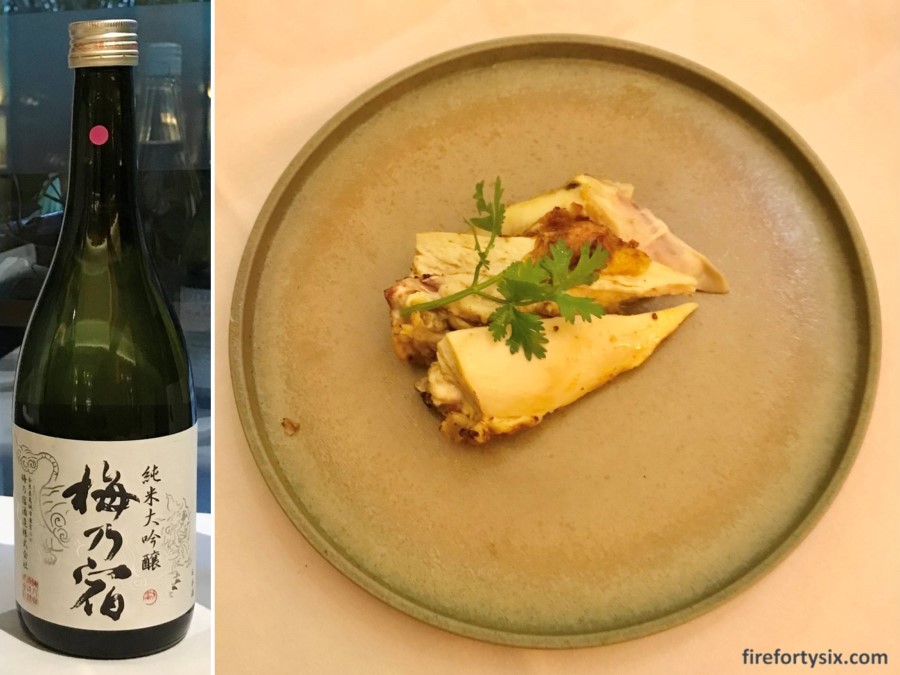
Just as I was starting to think that things were going well, our first disappointment arrived. It came in the form of a heavily-spiced roast chicken.
On hindsight, it was probably obvious that cumin was going to overwhelm any junmai daiginjo. But I suppose it was worth a shot putting it up against the strong-tasting SMV +3 Umenoyado from Nara prefecture.
It didn’t quite work, but I appreciate the valiant effort.
Round Four: Hakkaisan Junmai Daiginjo vs Steamed Clams in Chinese Fermented Rice, Hua Diao, Chinese Ham, Chicken Oil with Mushroom and Korean Glass Noodles
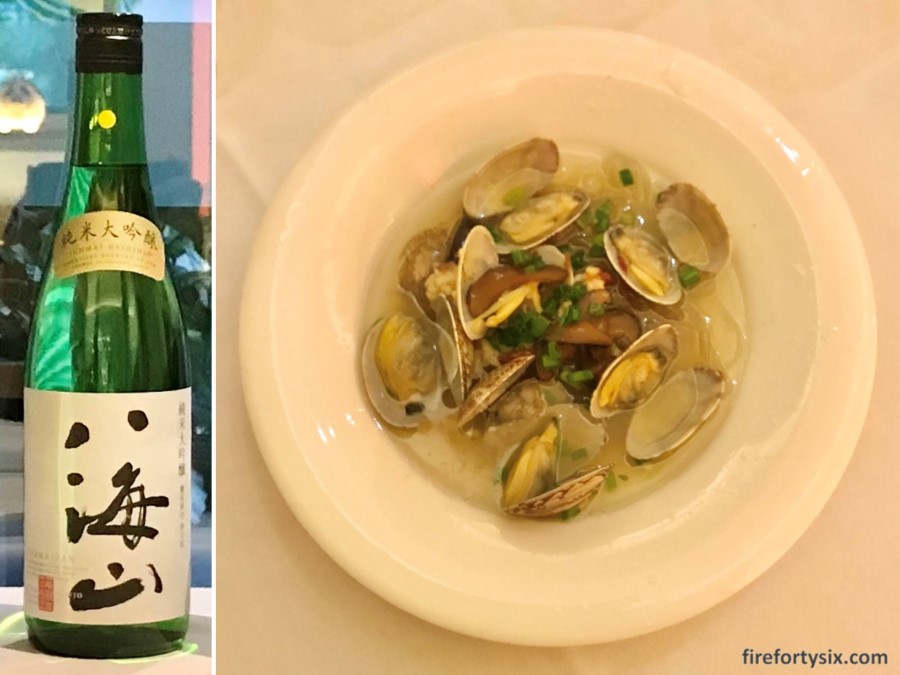
The name of the dish was definitely a mouthful and remarkably comprehensive. Despite the long roll-call of ingredients, I could distinctly make out each individual element. It was a glorious combination and easily the most delicious item that night.
All four of us were raving about it and were already making plans to come back again for dinner just to have this dish. But our joy was dashed when our waiter said that it was a special one-off item that was not on their regular menu.
How did the Hakkaisan stack up against the clams?
Unfortunately, not so well. I’m usually not a fan of dry Hakkaisans and this was rated +6 on the SMV scale. All I tasted was alcohol, and a better pairing for the dish would have been Chinese Pu’er tea.
Round Five: Nanbubijin Junmai Daiginjo Sakemirai Tenkei vs Cherry Pork with Steamed Winter Melon
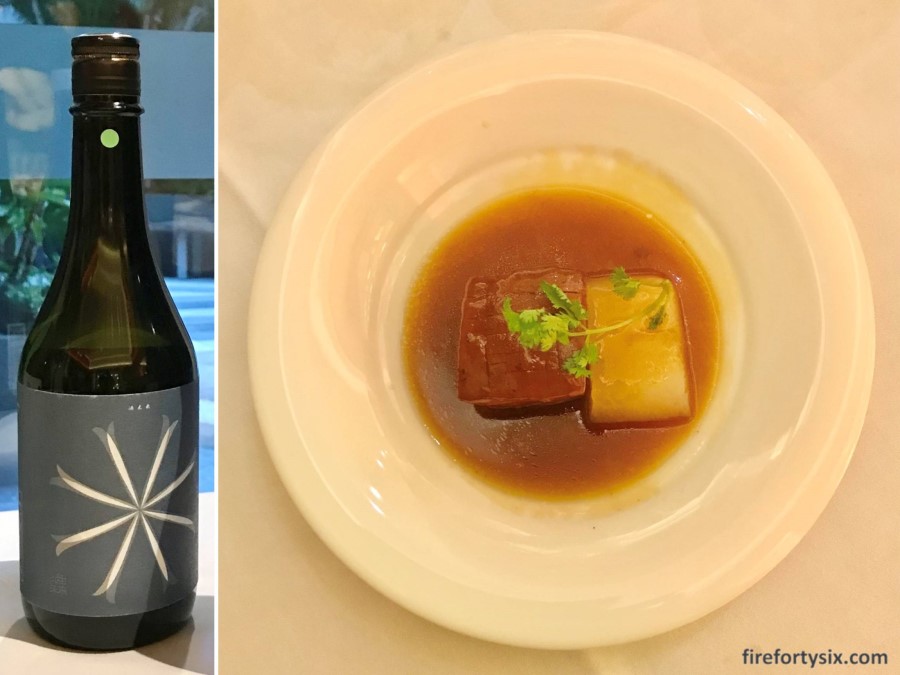
Before our server poured out the next bottle, she hyped it up by highlighting that it was made using Sakemirai rice, the same type used in the cult classic Juyondai. I’ve had several glasses of Juyondai in Tokyo before (at reasonable prices) , and they’ve always been great.
So, among all the bottles on the menu, this was the one I was looking forward to the most. But when I took the first sip, before having the pork, I felt let down because it was just meh. It lacked acidity and was nice, but didn’t live up to expectations.
I’ve had an Otokoyama junmai ginjo that was also made using Sakemirai, and that also didn’t live up to the hype. My learning point: rice varietal is important, but the brewer’s technique makes a big difference.
My disappointment would have been blunted if the cherry pork was good, but alas it wasn’t. The meat was overcooked and stringy, nowhere near the wonderful version we had before at Si Chuan Dou Hua.
Round Six: Born Junmai Daiginjo Ginsen vs Stewed Grouper with Bittergourd and Beancurd Skin in Claypot
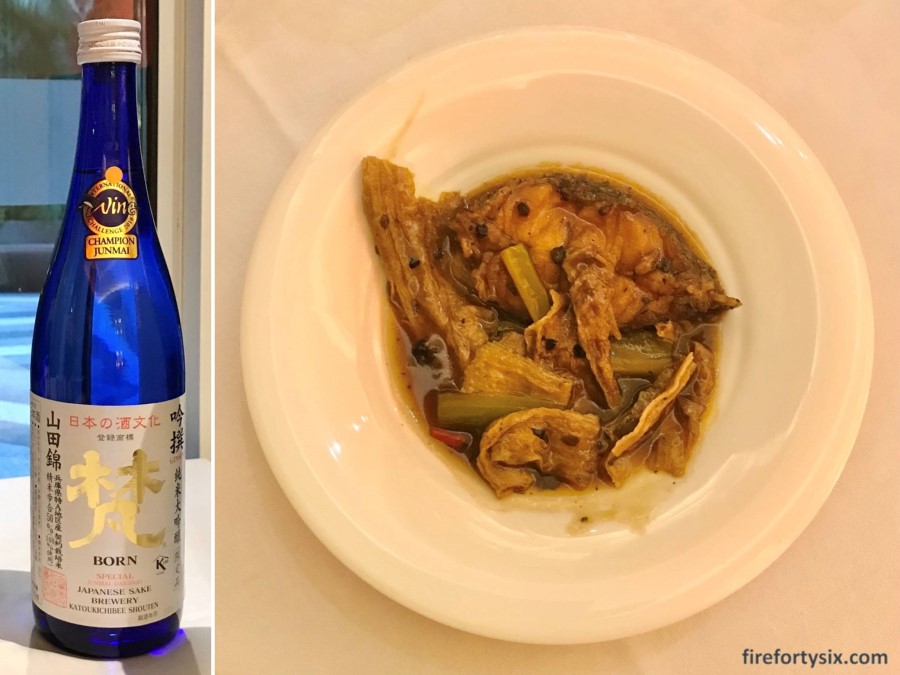
Luckily, the Born JDG Ginsen was next and it helped turn things around. One of our favourite sakes so far has been the sweet Born JDG Gold, and we also quite like the dryer Born JG Migaki 55. So this delicious glass made it a hat-trick, and sealed Born’s position as our favourite sake brand.
While the Born JDG Gold is best drunk on its own, either as an aperitif or digestif, the Born JDG Ginsen seems to taste better with heavily-sauced dishes like the stewed grouper. Its flavour turns mellow and sweet, and doesn’t get overwhelmed by food.
It was also during this dish that I found out that JM, like The Wife, is a fan of bittergourd. I now know two people with weird taste in food. Because everyone else is normal and hates the taste of bittergourd.
Round Seven: Stir-fried Spinach with Fresh Chinese Yam
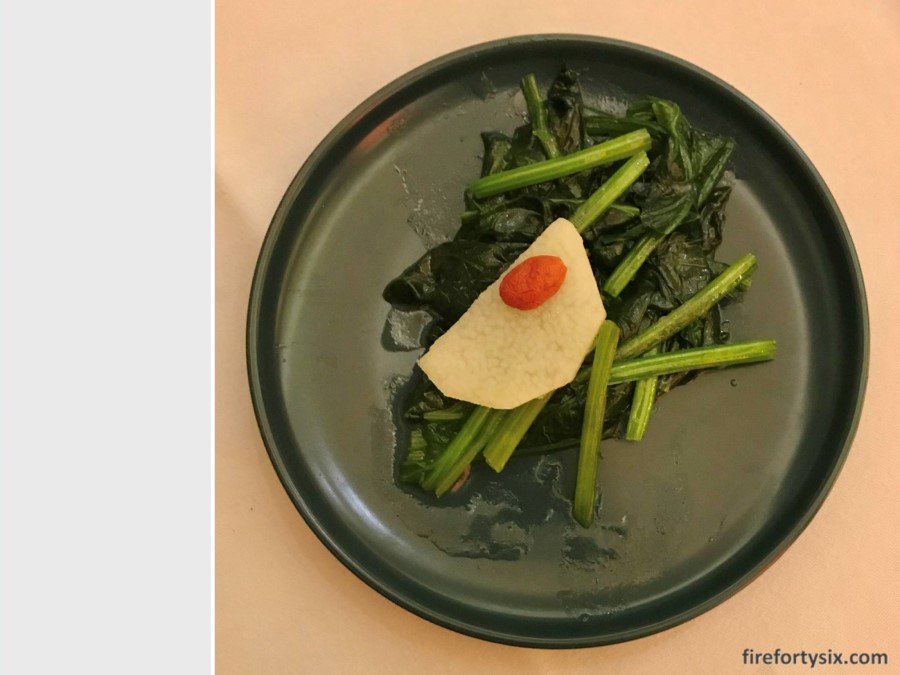
The obligatory vegetable dish was not paired with any sake. It was probably a wise decision because the spinach was, as expected, astringent with metallic notes. Any sake that you’d sip with it would have simply tasted strange.
Unlike typical Chinese course dinners, there was no final carbohydrate dish like a fried rice. Which was good because we were quite stuffed by then, and would have struggled to finish it anyway.
Another way to look at it was that we were already drinking liquid rice the entire meal, so there was no need to add the solid version?
Round Eight: Umenoyado Lychee Liqueur vs Chef’s Lychee Ice Cream
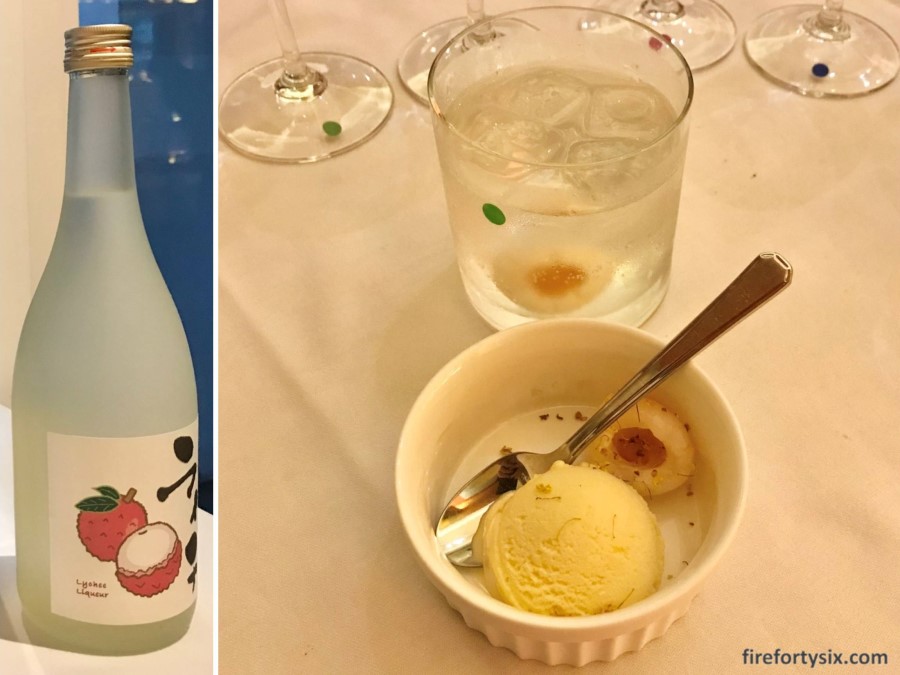
Finally, we reached the dessert course, which was a full-on lychee assault. From lychee liqueur to lychee ice cream, and in case that wasn’t enough, one entire lychee fruit each.
I didn’t mind the lychee overdose per-se, but the liqueur was way too sweet and both JM and I had to dilute it with water to make it drinkable. If you’re a huge lychee fan, the Umenoyado would be heaven sent, but just be careful what you wish for.
Final Thoughts
Overall, I’d say that it was an enjoyable sake-paired dinner.
With the exception of the cherry pork, the food was delicious and we’ll definitely be returning to Xi Yan to sample their ala carte menu. When we do, we’ll try and see if they can make that wonderful steamed clam dish for us again.
The sake pairing was hit-and-miss, with standouts like the Ohmine with oysters and the Born with stewed fish. But there were also mismatches like the Umenoyado, Hakkaisan and Nanbubijin with their respective dishes.
Logistics-wise, it would have been nicer if we didn’t have a glass fortress in front of us throughout the dinner. Serving each dish together with a glass of its specifically-paired sake would have been better.
Especially since there were timing mismatches where the dishes were served much later that their respective sakes, and we almost finished our drink before the food finally arrived. But again, we empathise with current staff constraints, and can accept these minor lapses.
Would I go for another sake-paired dinner with Chinese food again?
Probably not. But I would gladly open a bottle of sake the next time we go back to Xi Yan. And it will almost surely be a tried-and-tested bottle of Born .
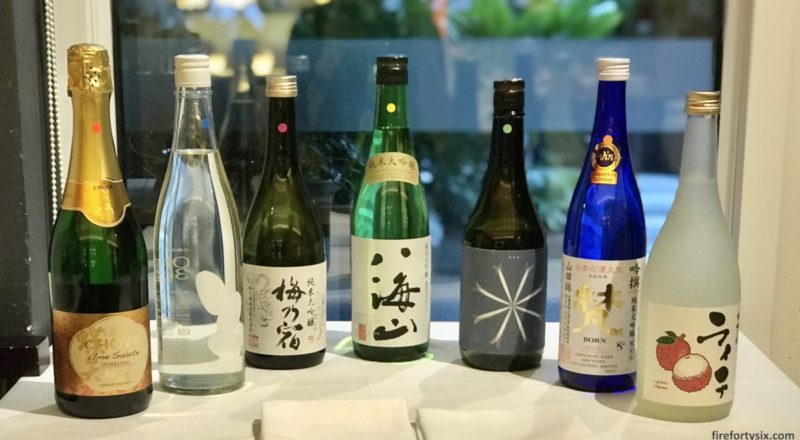
[…] had a one-night only junmai daiginjo sake dinner in his honor. They are located in Maxwell Chambers, a cozy and small building with a warm […]